Blue Is for Boys and Pink Is for Girls: How to Break Gender Stereotypes with a Videogame
Abstract
:1. Introduction
2. Related Work
2.1. Serious Games
2.2. Gender Stereotypes
2.3. Serious Games to Address Gender Issues
- Games for girls deal with gender differences and promote different concepts of femininity.
- Games designed to change gender stereotypes have the approach of creating awareness regarding sexism and gender stereotypes.
- Creative games are developed mostly for girls, encouraging girls to create and develop their own learning conditions and surroundings. Widely used in STEM (Science, Technology, Engineering, and Math), such projects are focused on bringing girls closer to the sciences [15].
3. Design and Development of the Kiddo Project
3.1. About the Kiddo Game
- Colors: “Blue is for boys and pink is for girls”;
- Educational: “Boys are better at math and girls are better at arts”;
- Physical activities: “Some sports are for girls, and some are for boys”;
- House activities and responsibilities: “Domestic chores are only for girls”.
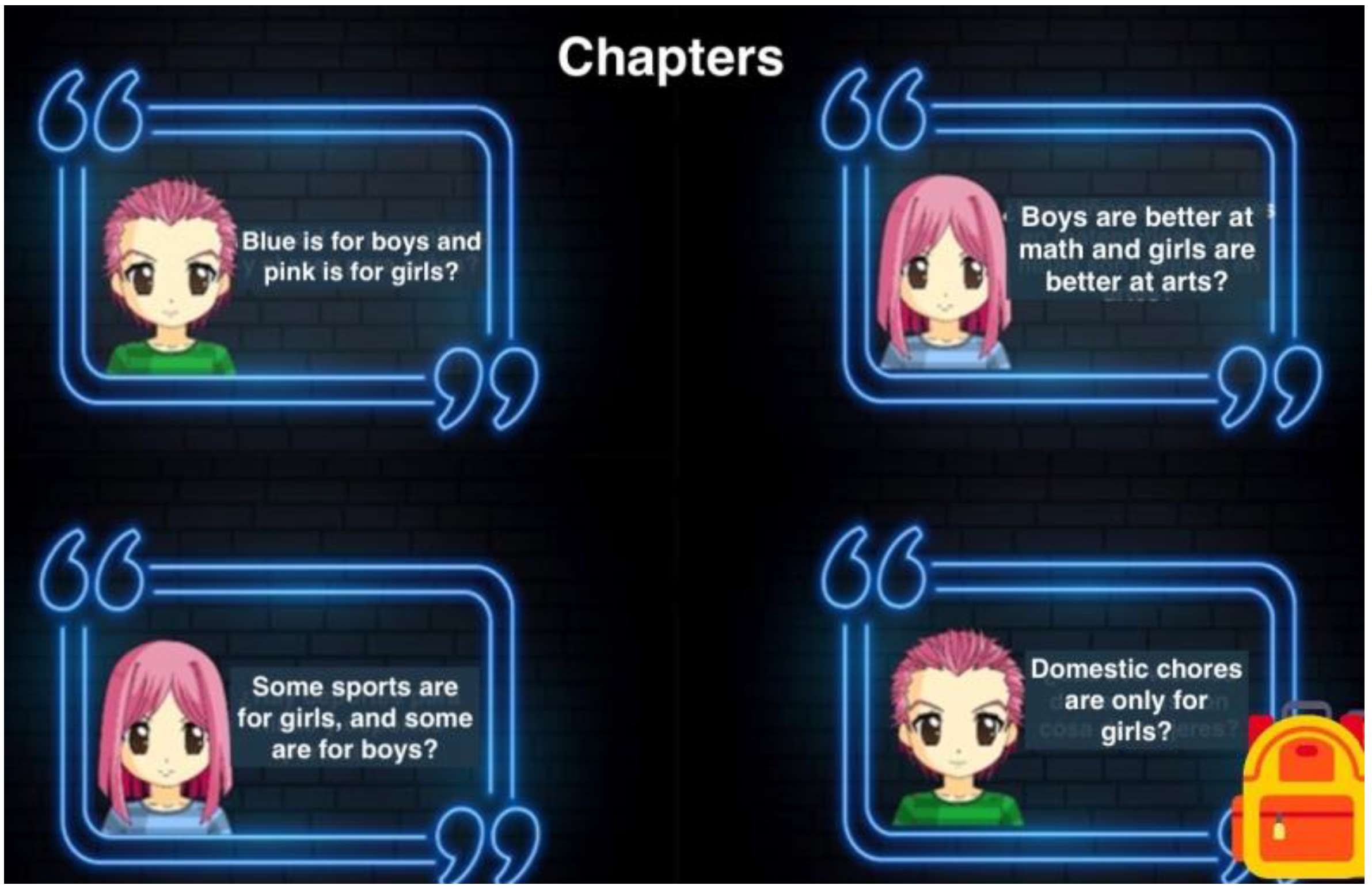
3.2. Design and Development
- I.
- The first evaluation (usability and acceptance evaluation)
- II.
- The second evaluation (formative evaluation with teachers)
3.3. Chapters of Kiddo
- The Kiddo game, which is based on stereotypes and roles commonly associated with gender, a topic especially relevant nowadays, must contain language that is easy to understand for children.
- The Kiddo game should complement and expand the equality education of the Secretary of Public Education programs, such as the one contained in Block 2, Sequence 3 (Building Equality Together) of the Civic and Ethical Formation book for third grade, edited by the Ministry of Public Education.
- The Kiddo game can be applied to groups in the fourth grade and later.
- Before being applied, Kiddo must be reviewed and approved by the General Directorate of Operation of Educational Services.
3.4. Game Learning Analytics Data Collection
3.5. Tools and Statistics
4. Initial Usability and Acceptance Evaluation
4.1. Methods
- I.
- Usability evaluation
- II.
- Acceptance evaluation
- III.
- Participants
- IV.
- Evaluations
4.2. Results of Initial Usability Evaluation
4.3. Results of Initial Acceptance Evaluation
- “I suggest creating and fighting the stereotypical monster of fear of decision making, it would be worthwhile to add to autonomy training”.
- “I liked the characters in general, but the monster is more attractive than the rest”.
- “Testing with children, as an adult you may not understand a lot of things, but children are more likely to find their way around faster”.
- “Add instructions and improve the style of the parent characters”.
- “The hearts representing the health or the life of the character, are really confusing. I thought that those were the Hearts of Courage, but they were life indicators”.
- “It is a very interesting proposal to present cases where analysis and decision making are encouraged. The design can be made more attractive, and the activities and challenges of the game can be related in a more direct way”.
- “I found the message of respect in terms of choice of tastes and gender interesting, but the story gets long with the dialogues, it would be good to include an introduction and instructions on how to play and at the end of the chapter a brief conclusion”.
5. Formative Evaluation with Teachers
5.1. Methods
- I.
- Questionnaires
- Have you managed to complete the game?
- Did you have any problems during the game?
- What did you like most about the videogame Kiddo?
- What did you not like about the videogame Kiddo and what would you change to improve it?
- What do you think of the story, do you find it interesting, funny, or appropriate?
- What has the game made you think about?
- What would you like to see us add or remove in the following chapters to improve the story?
- Can this game be used in the classroom, and how would you apply it?
- II.
- Participants
- III.
- Evaluation
- “Girls and boys have the same rights and should have the same opportunities for their development”.
- “The social roles of women and men”.
- “Actions that favor equal treatment between girls and boys at school”.
- Once the development was completed, an invitation was launched so that interested teachers could participate in the evaluation.
5.2. Results of Formative Evaluation with Teachers
- The Neutral group maintained their attitude towards equality. Generally, participants in this group were already showing a positive attitude towards gender equality.
- The Positive group had a positive attitude change towards equality. This group showed a sexist stereotype-oriented attitude in the pre-test and a decreased sexist attitude in the post-test.
- The Negative group had a negative attitude change. In this group, participants showed a positive attitude in the pre-test but had an increased sexist attitude after playing the game. We had a couple of outlier cases in which different situations (reading errors, errors in writing on sheets of paper, or problems in understanding the questions) could have affected the results.
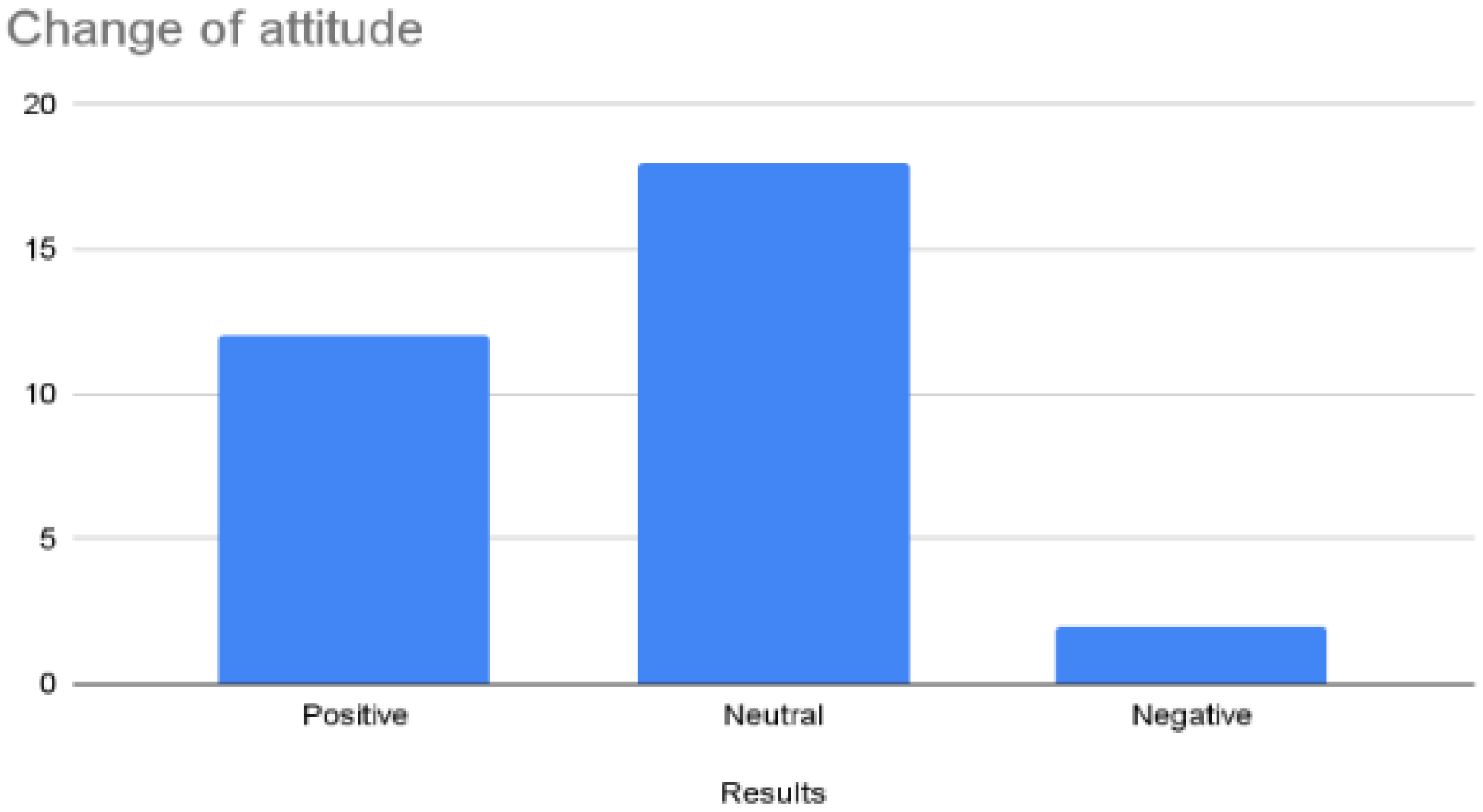
- “With the game I have learned about equality”: Most of the participants stated that with the videogame, they have learned about equality.
- “The game has allowed me to do the activity without external help”: Most of the participants managed to finish the videogame without help; meanwhile, a few older participants required a preliminary explanation of how to play the videogame and how to use the computer.
- “The game feels rigid and seems like a directed activity”: Most of the participants felt that the activity is friendly, i.e., not rigid.
- “At times I felt lost and not knowing what to do”: Most of the participants felt lost at some point in the videogame.
- “The videogame has allowed me to make mistakes and learn from them”: Most participants felt that during the game, when they made mistakes, they were able to learn from them in order to not repeat them and to finish each chapter of the videogame.
- “In the videogame I have been able to choose different alternatives to solve it”: Most of the participants mentioned that they had different alternatives to solving the videogame and followed their own decisions.
- “Videogame activity is fun”: Most of the participants mentioned that the activity was fun.
- “Learning with a videogame is better than an equality class (civic and ethical training)”: Most of the participants mentioned that they totally agree with the phrase “learning with a videogame is better than an equality class”.
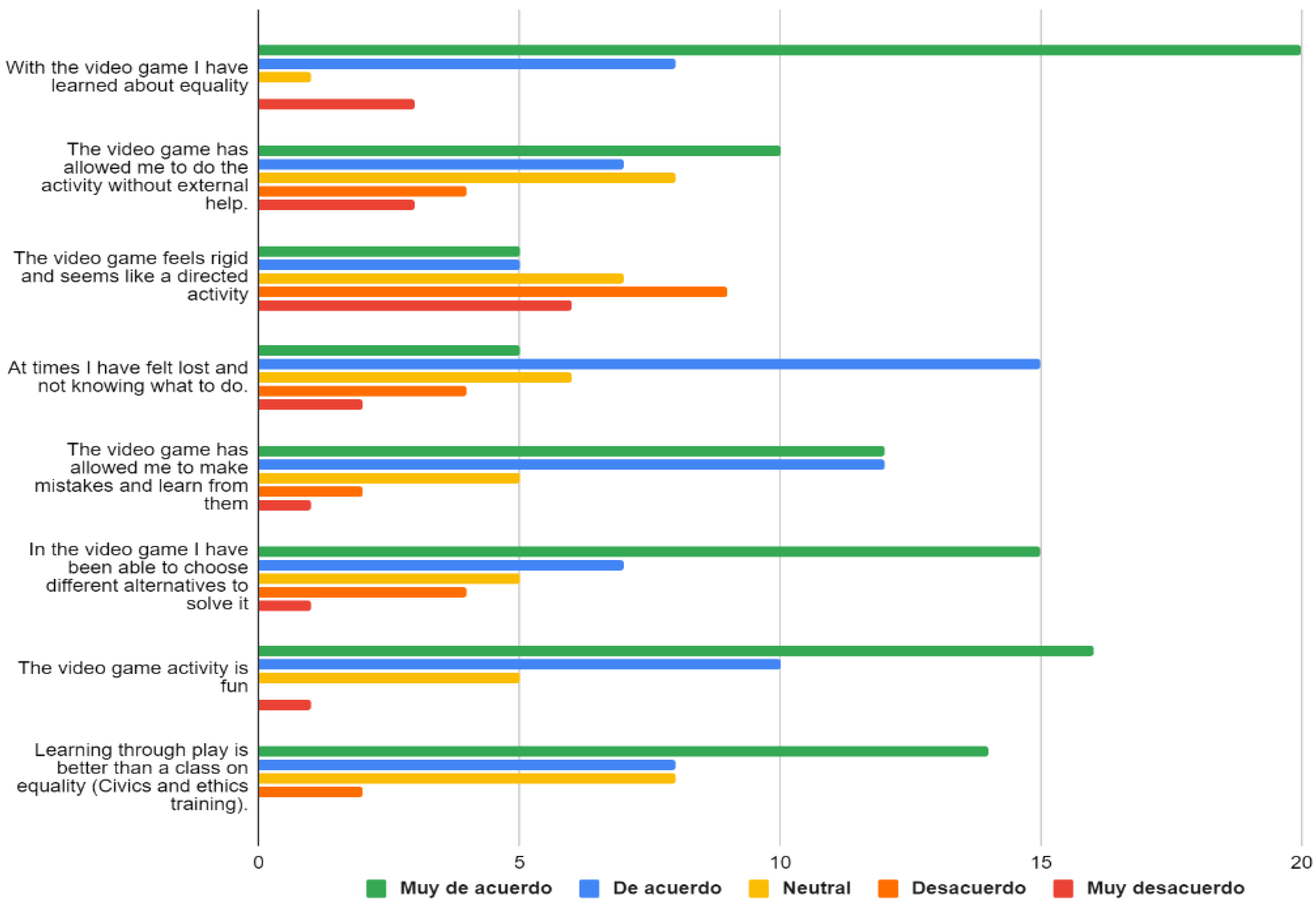
6. Discussion
6.1. Usability and Acceptance Evaluation
6.2. Formative Evaluation with Teachers
6.3. Limitations
7. Conclusions
Author Contributions
Funding
Institutional Review Board Statement
Informed Consent Statement
Data Availability Statement
Conflicts of Interest
Appendix A
| Demographic Data |
| How old are you? Numeric field (2 digits) |
| What is the school grade you are teaching? Third grade Fourth grade Fifth grade teachers, Sixth grade teachers, Other grades or specific disciplines |
| What is your sex? Female Male I’d rather not answer |
Appendix B
| Diagnostic Statements of Sexist Behavior |
| The man is in charge at home El hombre es el que manda en casa Totally agree (5), Agree (4), Neither Agree or Disagree (3), Disagree (2), Strongly disagree (1) |
| Women should always obey men Las mujeres siempre deben obedecer a los hombres Totally agree (5), Agree (4), Neither Agree or Disagree (3), Disagree (2), Strongly disagree (1) |
| Men work, women stay at home El hombre trabaja, la mujer se queda en casa Totally agree (5), Agree (4), Neither Agree or Disagree (3), Disagree (2), Strongly disagree (1) |
| The woman is the one who should take care of the family La mujer es la que debe cuidar de la familia Totally agree (5), Agree (4), Neither Agree or Disagree (3), Disagree (2), Strongly disagree (1) |
Appendix C
| Statements on Gender Stereotypes |
| There are special colors for girls and unique colors for boys. Hay colores especiales para niñas y colores únicos para niños Totally agree (5), Agree (4), Neither Agree or Disagree (3), Disagree (2), Strongly disagree (1) |
| Blue color is for boys and pink color for girls. El color azul es para los niños y el color rosa para las niñas Totally agree (5), Agree (4), Neither Agree or Disagree (3), Disagree (2), Strongly disagree (1) |
| Boys should not cry. Los niños no deben llorar Totally agree (5), Agree (4), Neither Agree or Disagree (3), Disagree (2), Strongly disagree (1) |
| It is not right for boys to play with dolls, because this is a girl’s game. No está bien que los niños jueguen con muñecas, porque este es un juego de niñas Totally agree (5), Agree (4), Neither Agree or Disagree (3), Disagree (2), Strongly disagree (1) |
| Girls should not do manly things like rough sports. Las niñas no deben hacer cosas de hombres como los deportes rudos Totally agree (5), Agree (4), Neither Agree or Disagree (3), Disagree (2), Strongly disagree (1) |
| Only boys are strong. Solo los niños son fuertes Totally agree (5), Agree (4), Neither Agree or Disagree (3), Disagree (2), Strongly disagree (1) |
| Girls are weak and delicate. Las niñas son débiles y delicadas Totally agree (5), Agree (4), Neither Agree or Disagree (3), Disagree (2), Strongly disagree (1) |
| Girls should not play rough. Las niñas no deben jugar rudo Totally agree (5), Agree (4), Neither Agree or Disagree (3), Disagree (2), Strongly disagree (1) |
| Men should not help with housework at home Los hombres no deben ayudar con las labores domésticas en casa Totally agree (5), Agree (4), Neither Agree or Disagree (3), Disagree (2), Strongly disagree (1) |
| Only girls should learn how to do housework Solo las niñas deben aprender a hacer labores domésticas Totally agree (5), Agree (4), Neither Agree or Disagree (3), Disagree (2), Strongly disagree (1) |
| Only men can use tools at home Solo los hombres pueden usar herramientas en casa Totally agree (5), Agree (4), Neither Agree or Disagree (3), Disagree (2), Strongly disagree (1) |
| Boys can be leaders, but girls should only dream of being mothers. Los niños pueden ser líderes, pero las niñas deben soñar solamente con ser madres Totally agree (5), Agree (4), Neither Agree or Disagree (3), Disagree (2), Strongly disagree (1) |
| It is not important that girls study No es importante que las niñas estudien Totally agree (5), Agree (4), Neither Agree or Disagree (3), Disagree (2), Strongly disagree (1) |
| Girls are not good at math Las niñas no son buenas en matemáticas Totally agree (5), Agree (4), Neither Agree or Disagree (3), Disagree (2), Strongly disagree (1) |
| Boys should not like art A los niños no debería gustarles el arte Totally agree (5), Agree (4), Neither Agree or Disagree (3), Disagree (2), Strongly disagree (1) |
| Boys make better decisions than girls Los niños toman mejores decisiones que las niñas Totally agree (5), Agree (4), Neither Agree or Disagree (3), Disagree (2), Strongly disagree (1) |
Appendix D
| User Experience |
| Through the game I have learned about equality Con el juego he aprendido sobre igualdad Totally agree (5), Agree (4), Neither Agree or Disagree (3), Disagree (2), Strongly disagree (1) |
| The game allowed me to do the activity without external help. El juego me ha permitido hacer la actividad sin ayuda externa Totally agree (5), Agree (4), Neither Agree or Disagree (3), Disagree (2), Strongly disagree (1) |
| I found it to be a very rigid and directed activity. Me ha parecido una actividad muy rígida y dirigida Totally agree (5), Agree (4), Neither Agree or Disagree (3), Disagree (2), Strongly disagree (1) |
| At times I have felt lost and not knowing what to do. En algunos momentos me he sentido perdido y sin saber qué hacer Totally agree (5), Agree (4), Neither Agree or Disagree (3), Disagree (2), Strongly disagree (1) |
| The game has allowed me to make mistakes and learn from them. El juego me ha permitido cometer errores y aprender de ellos Totally agree (5), Agree (4), Neither Agree or Disagree (3), Disagree (2), Strongly disagree (1) |
| In the game I have been able to choose different alternatives to solve it En el juego he podido elegir distintas alternativas para resolverlo Totally agree (5), Agree (4), Neither Agree or Disagree (3), Disagree (2), Strongly disagree (1) |
| Activity with the game is fun La actividad con el juego es divertida Totally agree (5), Agree (4), Neither Agree or Disagree (3), Disagree (2), Strongly disagree (1) |
| Learning through play is better than a class on equality (Civics and ethics training). Aprender con el juego es mejor que una clase de igualdad (Formación cívica y ética) Totally agree (5), Agree (4), Neither Agree or Disagree (3), Disagree (2), Strongly disagree (1) |
Appendix E
| Opinions |
| 1. Have you managed to complete the game? ¿Has logrado completar el juego? |
| 2. Did you have any problems during the game? ¿Tuviste algún problema durante el juego? |
| 3. What did you like most about the videogame “Kiddo”? ¿Qué es lo que más te ha gustado del videojuego “Kiddo”? |
| 4. What did you not like about the videogame “Kiddo” and what would you change to improve it? ¿Qué no te ha gustado del videojuego “Kiddo” y qué cambiarías para mejorarlo? |
| 5. What do you think of the story, do you find it interesting, funny, or appropriate? ¿Qué opinas de la historia?, ¿te parece interesante, divertida o apropiada? |
| 6. What has the game made you think about? ¿El juego te ha hecho reflexionar? ¿Sobre qué? |
| 7. What would you like to see us add or remove in the following chapters to improve the story? ¿Qué te gustaría que añadiéramos o elimináramos en los siguientes capítulos para mejorar la historia? |
| 8. Can this game be used in the classroom, and how would you apply it? ¿Puede usarse este juego dentro del aula? ¿Cómo lo aplicarías? |
References
- Barrera, A.; Alonso-Fernández, C.; Fernández-Manjón, B. Acceptance evaluation of a serious game to address gender stereotypes in Mexico. In Proceedings of the 7th Annual International Symposium on Emerging Technologies for Education in Conjunction with ICWL 2022 (SETE 2022), Tenerife, Spain, 21–23 November 2022. [Google Scholar]
- Michael, D.R.; Chen, S.L. Serious Games: Games That Educate, Train, and Inform. Education 2005, 31, 1–95. [Google Scholar] [CrossRef]
- Calvo-Morata, A.; Alonso-Fernández, C.; Freire, M.; Martínez-Ortiz, I.; Fernández-Manjón, B. Creating awareness on bullying and cyberbullying among young people: Validating the effectiveness and design of the serious game Conectado. Telemat. Inform. 2021, 60, 101568. [Google Scholar] [CrossRef]
- Aubert, A.H.; Bauer, R.; Lienert, J. A review of water-related serious games to specify use in environmental Multi-Criteria Decision Analysis. Environ. Model. Softw. 2018, 105, 64–78. [Google Scholar] [CrossRef]
- Pitarch, R.C. An Approach to Digital Game-based Learning: Video-games Principles and Applications in Foreign Language Learning. J. Lang. Teach. Res. 2018, 9, 1147. [Google Scholar] [CrossRef]
- Gender Stereotyping. OHCHR and Women’s Human Rights and Gender Equality. Available online: https://www.ohchr.org/en/women/gender-stereotyping (accessed on 2 February 2023).
- Hietanen, A.E.; Pick, S. Gender Stereotypes, Sexuality, and Culture in Mexico. In Psychology of Gender through the Lens of Culture; Safdar, S., Kosakowska-Berezecka, N., Eds.; Springer: Cham, Switzerland, 2015. [Google Scholar] [CrossRef]
- Azaola, E. Patrones, Estereotipos y Violencia de Género en las Escuelas de Educación Básica en México. La Ventana. Rev. Estud. Género 2009, 4, 7–45. Available online: https://www.scielo.org.mx/scielo.php?pid=S1405-94362009000200003&script=sci_abstract (accessed on 2 February 2023).
- Denner, J.; Laursen, B.; Dickson, D.; Hartl, A.C. Latino Children’s Math Confidence: The Role of Mothers’ Gender Stereotypes and Involvement Across the Transition to Middle School. J. Early Adolesc. 2018, 38, 513–529. [Google Scholar] [CrossRef]
- Chang, A.; Sandhofer, C.M.; Brown, C.S. Gender Biases in Early Number Exposure to Preschool-Aged Children. J. Lang. Soc. Psychol. 2011, 30, 440–450. [Google Scholar] [CrossRef]
- Tsiunas un Videojuego Para Transformar las Relaciones Desiguales Entre Mujeres y Hombres. Available online: https://colombia.unwomen.org/es/noticias-y-eventos/articulos/2018/5/tsiunas (accessed on 2 February 2023).
- Jesse—A None in Three Game. Available online: http://www.noneinthree.org/barbados-and-grenada/jesse/ (accessed on 2 February 2023).
- The Island Network for Gender Equality “Tenerife Violeta”, “Berolos”. 2020. Available online: https://www.tenerifevioleta.es/berolos/ (accessed on 2 February 2023).
- Instituto Andaluz de la Mujer (Spain), “IGUALA-T”. 2018. Available online: http://www.iguala-t.es/app/login (accessed on 2 February 2023).
- Yasmin, B.K. Considering gender in digital games: Implications for serious game designs in the learning sciences. In Proceedings of the 8th International Conference on International Conference for the Learning Sciences—(ICLS’08), Utrecht, The Netherlands, 23–28 June 2008; International Society of the Learning Sciences: Buffalo, NY, USA, 2008; Volume 1, pp. 422–429. [Google Scholar]
- Barrera Yañez, A.G.; Alonso-Fernandez, C.; Fernandez Manjon, B. Review of serious games to educate on gender equality. In Proceedings of the Eighth International Conference on Technological Ecosystems for Enhancing Multiculturality, Salamanca, Spain, 21–23 October 2020; pp. 662–668. [Google Scholar] [CrossRef]
- Chuka. Available online: http://www.chukagame.com/ (accessed on 2 February 2023).
- Pérez Colado, V.M.; Pérez Colado, I.J.; Manuel, F.; Martínez-Ortiz, I.; Fernández-Manjón, B. Simplifying the creation of adventure serious games with educational-oriented features. Educ. Technol. Soc. 2019, 22, 32–46. [Google Scholar]
- Freire, M.; Serrano-Laguna, Á.; Iglesias, B.M.; Martínez-Ortiz, I.; Moreno-Ger, P.; Fernández-Manjón, B. Game Learning Analytics: Learning Analytics for Serious Games. In Learning, Design, and Technology; Springer International Publishing: Cham, Switzerland, 2016; pp. 1–29. [Google Scholar] [CrossRef]
- Garena Free Fire, Usablity/Satisfaction Survey. Available online: https://www.surveycake.com/s/9PVwx (accessed on 2 February 2023).
- Jozkowski, K.N.; Ekbia, H.R. “Campus Craft”: A Game for Sexual Assault Prevention in Universities. Games Health J. 2015, 4, 95–106. [Google Scholar] [CrossRef] [PubMed]
- Marchal Torralbo, A.M.; Brando Garrido, C.; Montes Hidalgo, J.; Tomás Sábado, J. Diseño y validación de un instrumento para medir actitudes machistas, violencia y estereotipos en adolescentes. Metas de Enfermería 2018, 21, 11–18. [Google Scholar] [CrossRef]
- Fondo de las Naciones Unidas para la Infancia (UNICEF) Junio. 2019. Available online: https://www.unicef.org/chile/media/3076/file/lacro-igualdad.pdf (accessed on 2 February 2023).
- Formación Cívica y Ética. Tercer Grado. Primaria. Dirección General de Materiales Educativos. Secretaría de Educación Pública. 2022. Available online: https://libros.conaliteg.gob.mx/2022/P3FCA.htm#page/1 (accessed on 2 February 2023).
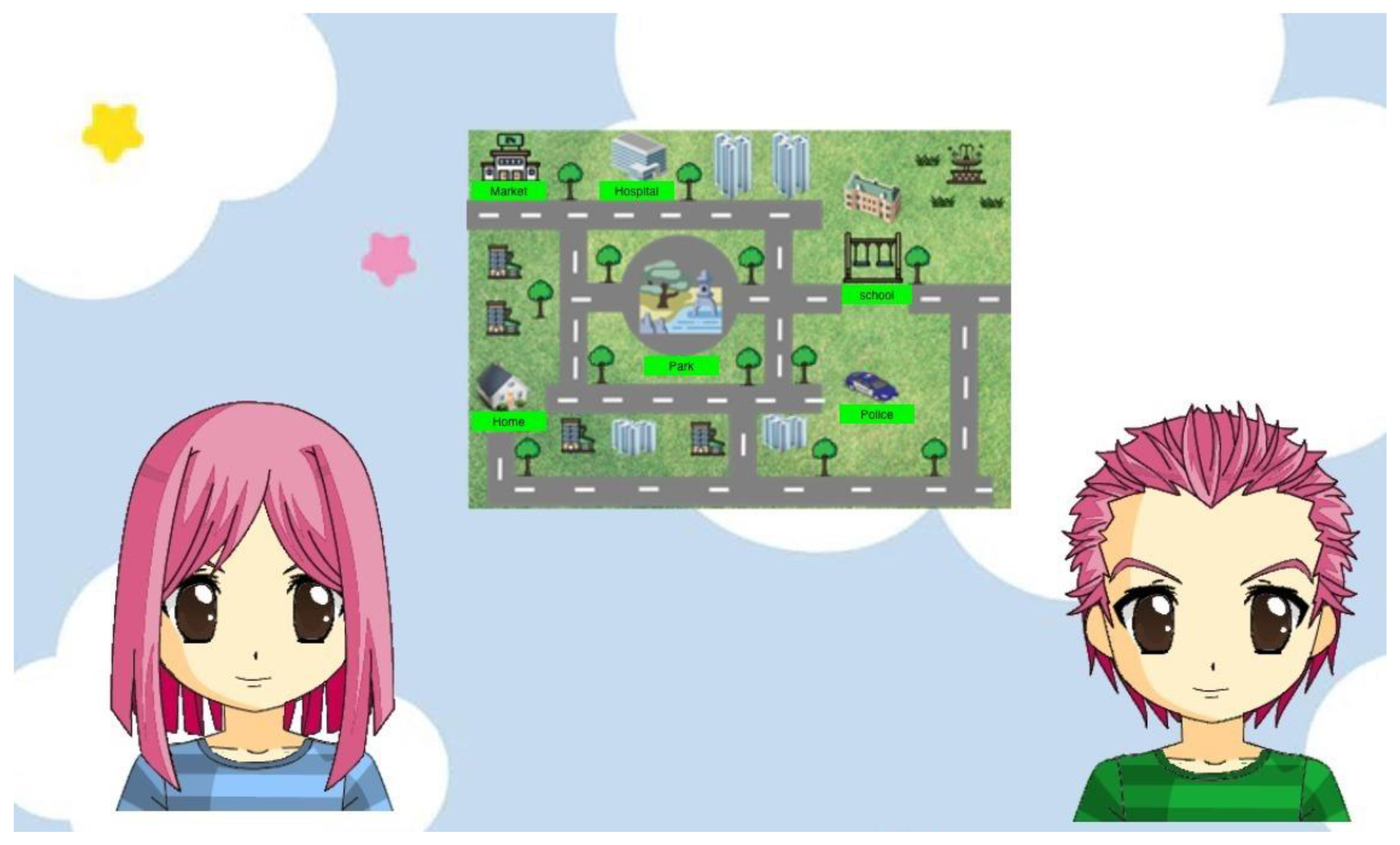
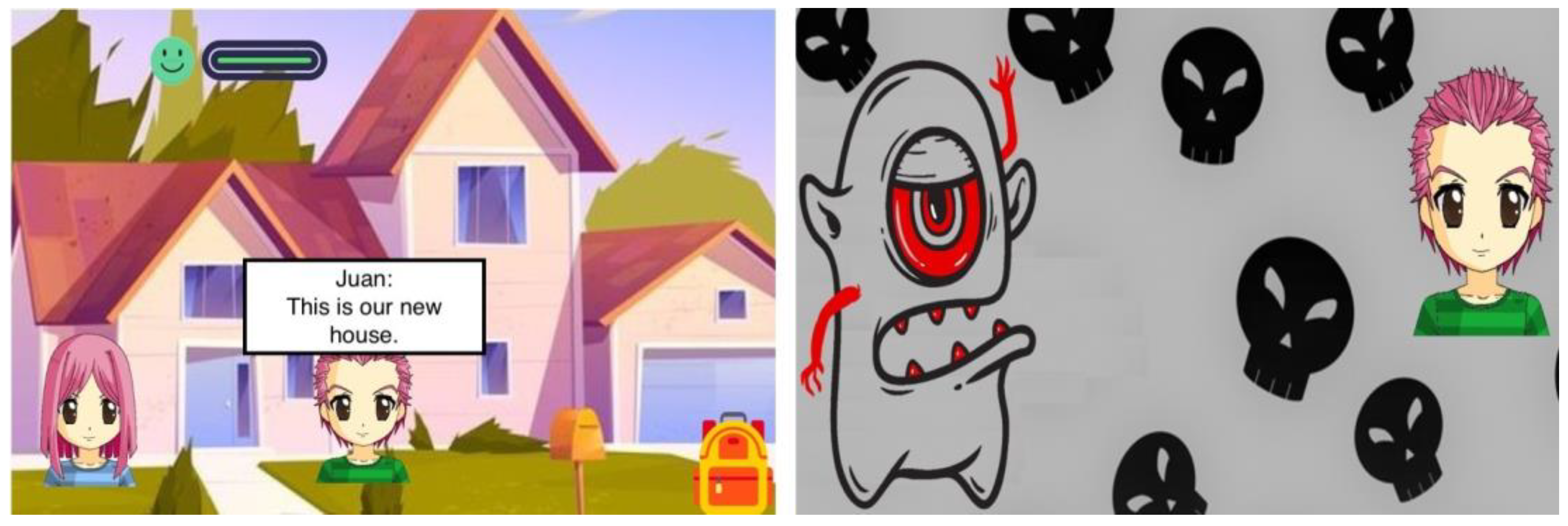
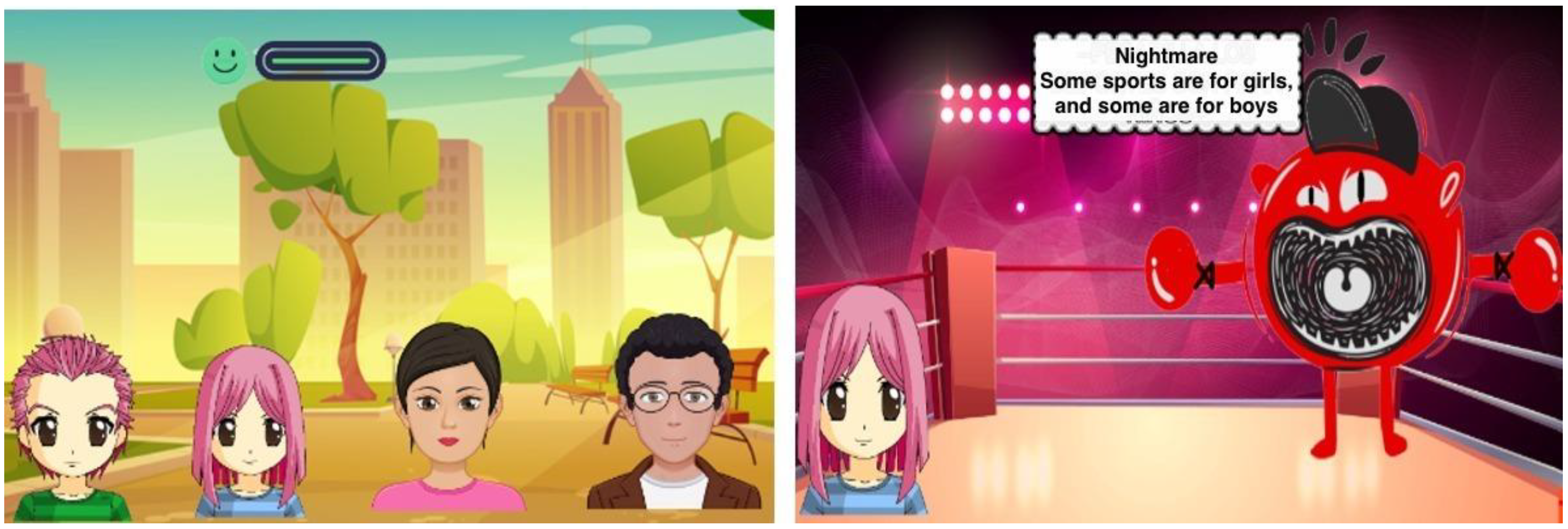

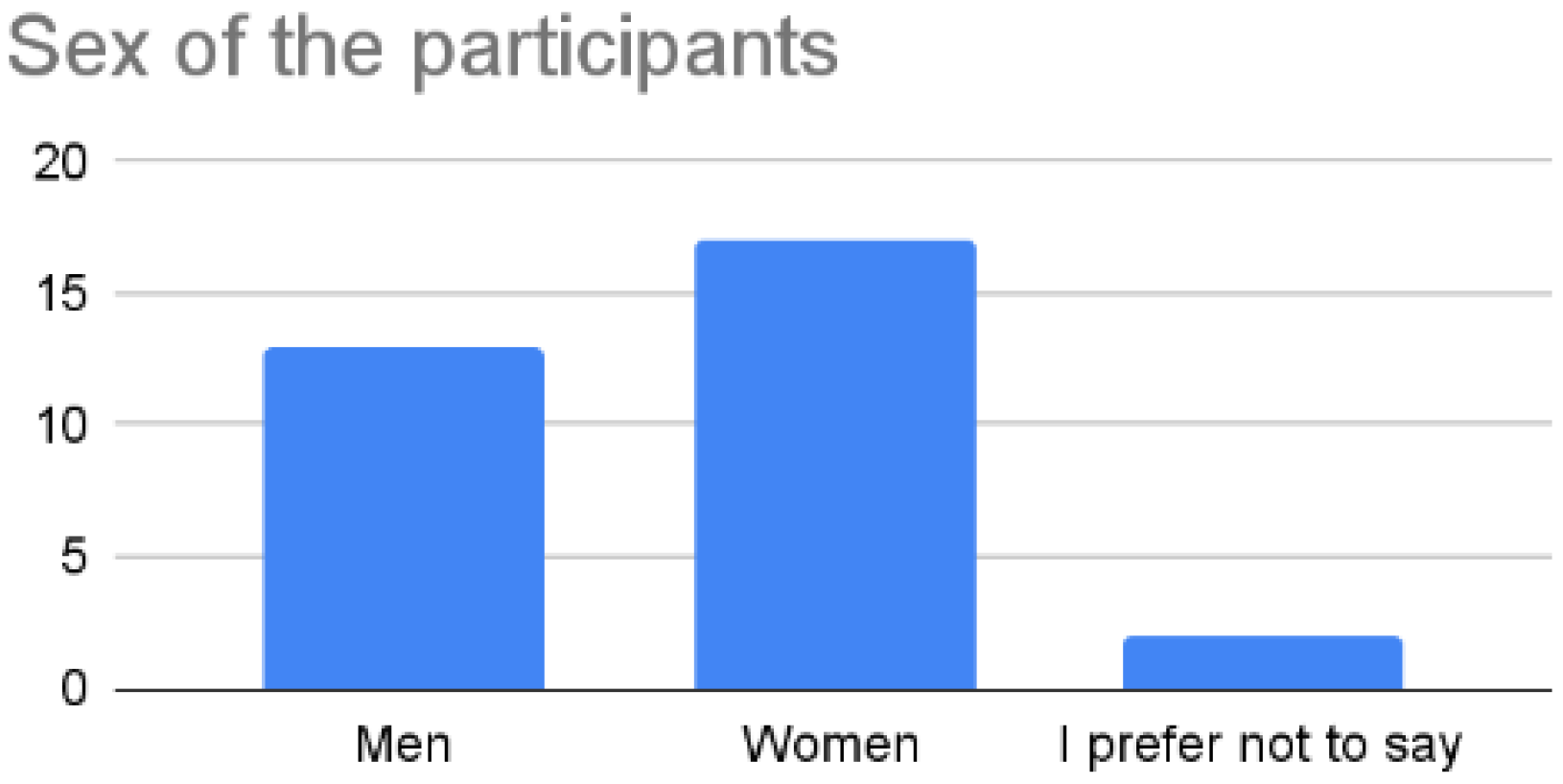
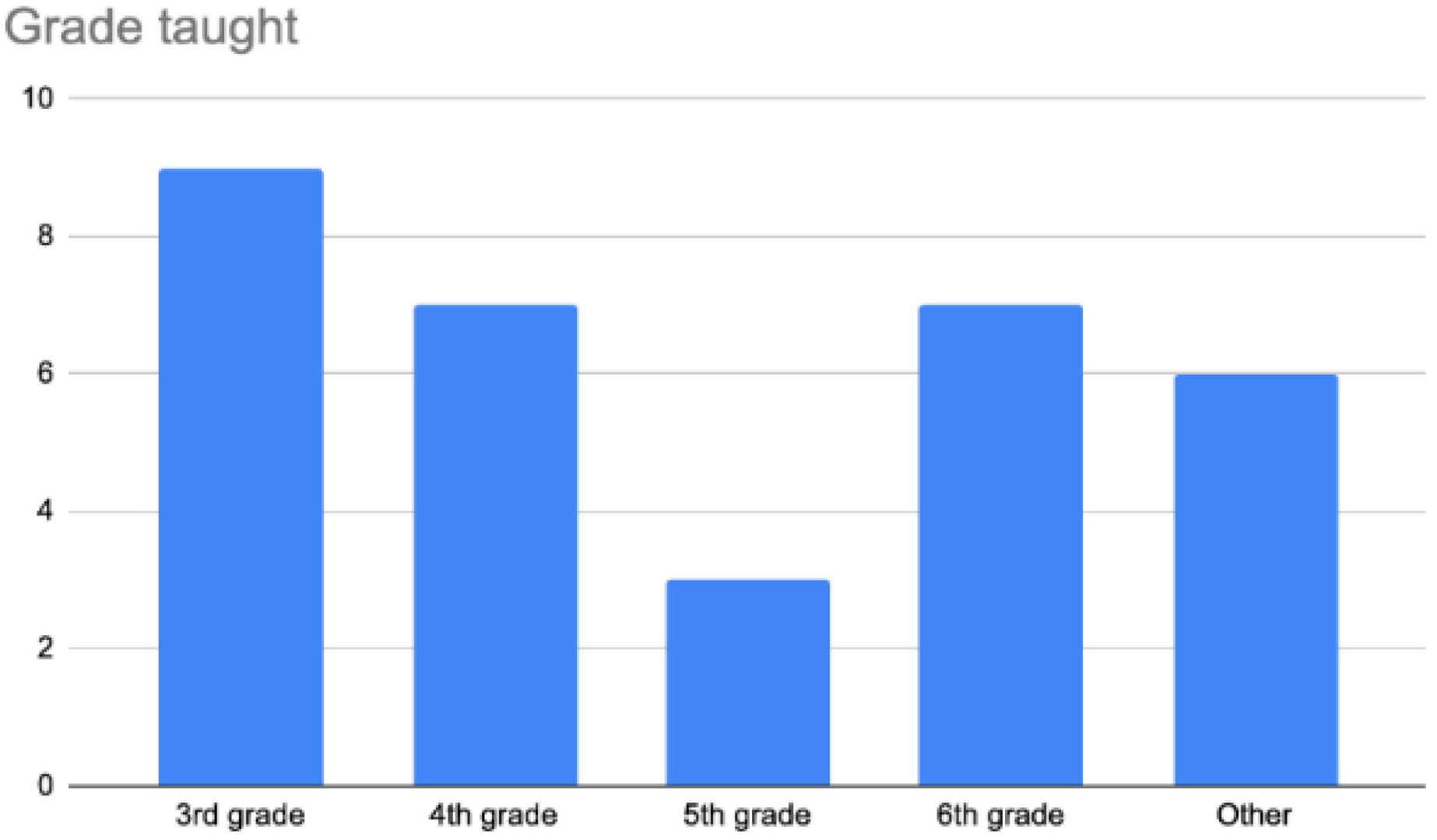
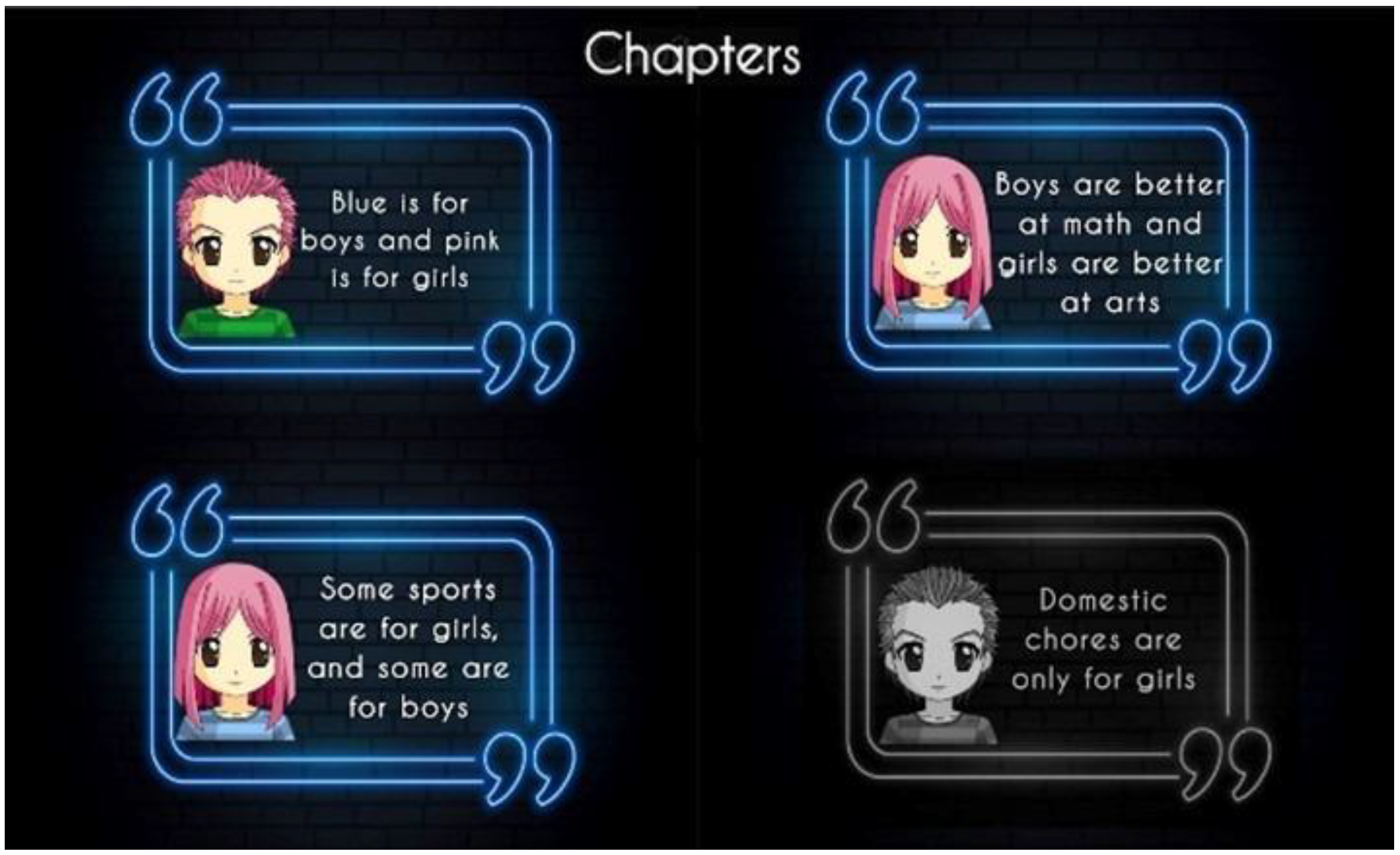
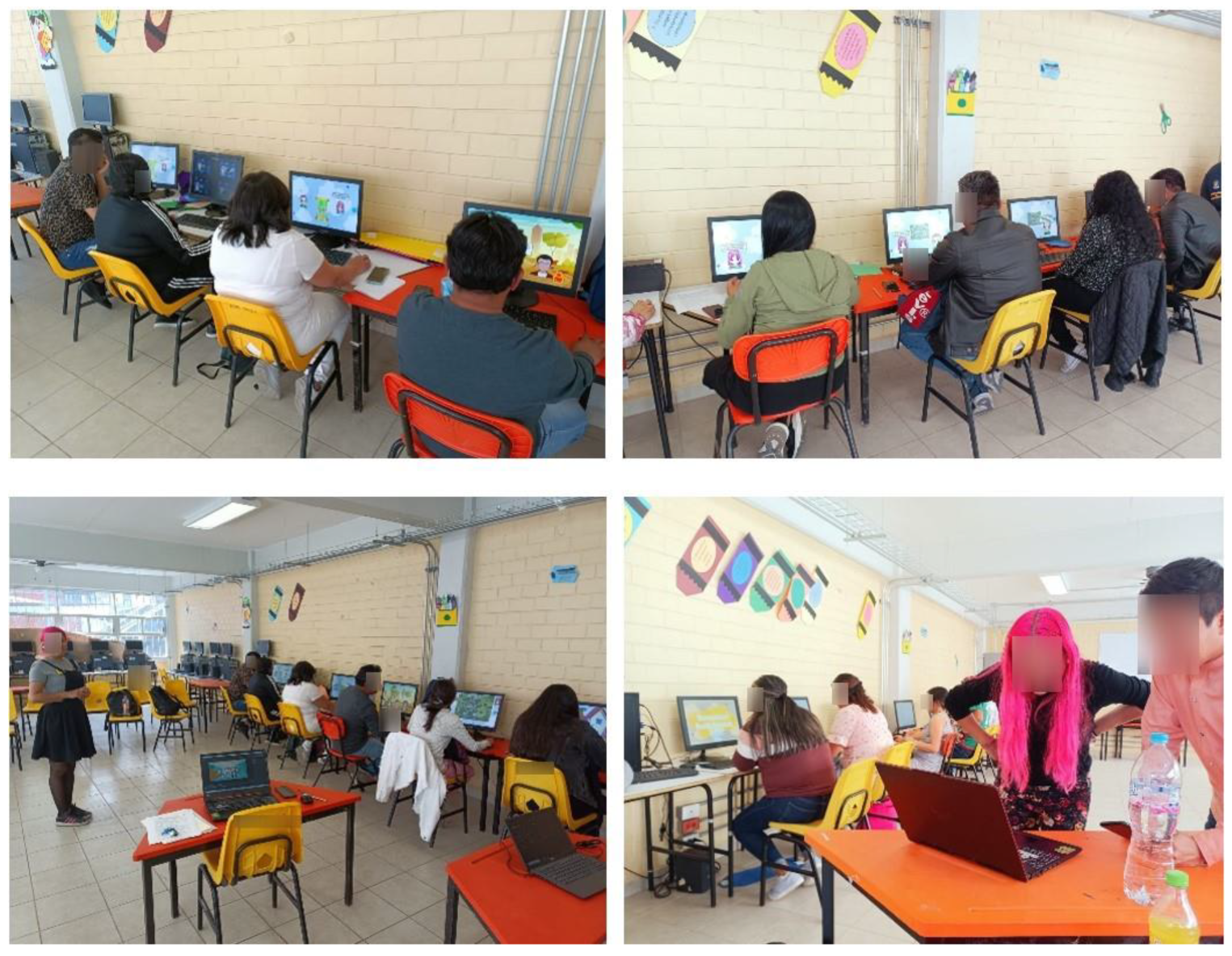

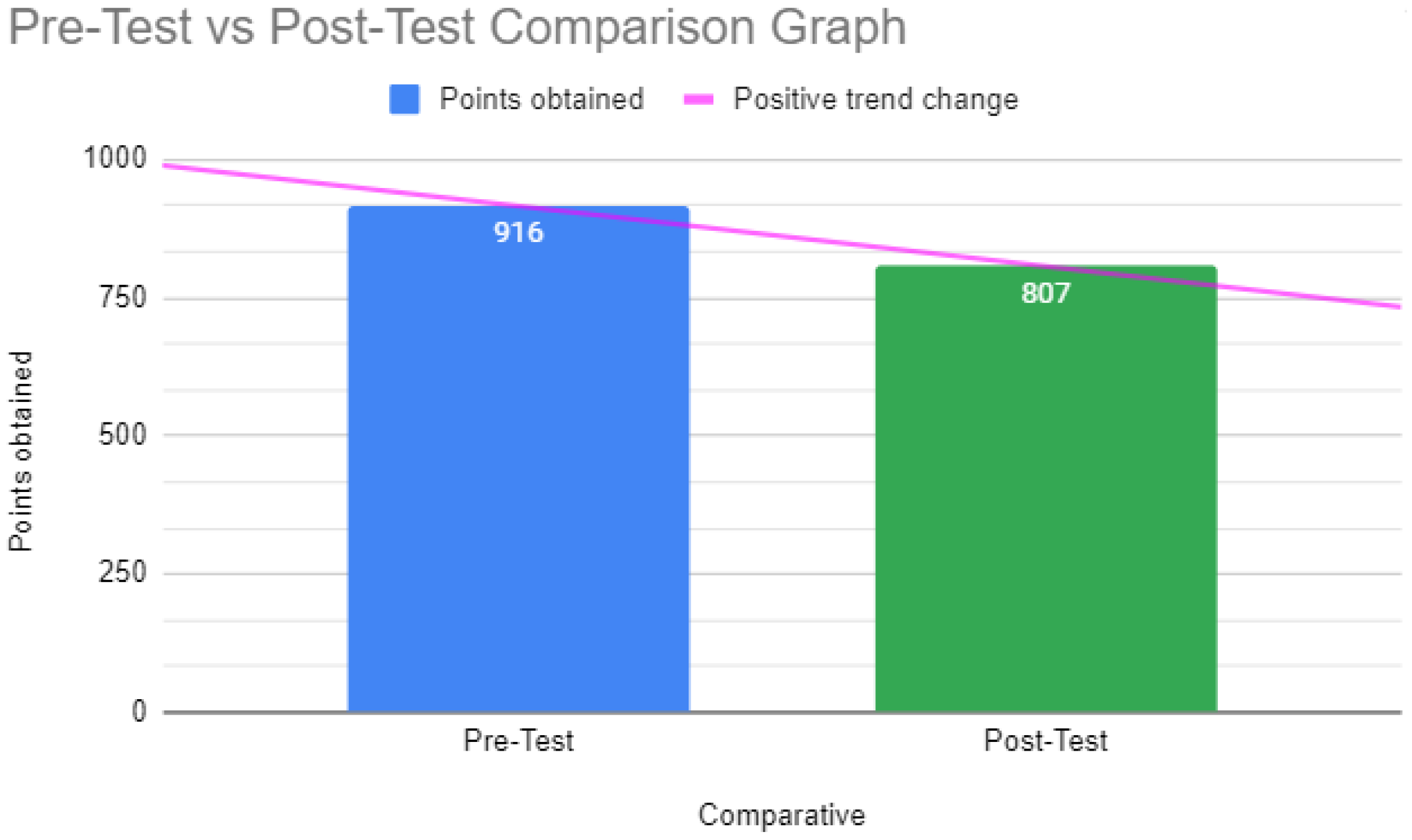
| Gender Stereotype | % of Boys Who Agree | % of Girls Who Agree |
|---|---|---|
| Boys need to finish school and prepare themselves to maintain their future home. | 85.7 | 82.0 |
| Girls should learn to help out at home by taking care of their siblings and cleaning up. | 78.8 | 78.9 |
| The man is the one who should have the greatest responsibility for bringing money into the home. | 77.3 | 75.2 |
| Girls should play with dolls. | 75.2 | 71.7 |
| Boys should play soccer and other hard-core sports. | 70.8 | 62.8 |
| The woman is the one who has to be careful not to become pregnant. | 67.1 | 69.6 |
| Usability Question | |
|---|---|
| 1 | Were you able to talk to all the characters? |
| 2 | Were you able to collect all the items? |
| 3 | Were you able to use the objects correctly? |
| 4 | Were you able to interact with the map? |
| 5 | Were the game instructions clear? |
| 6 | Were the buttons easy to find? |
| 7 | Did you find any buttons that did not work correctly? |
| 8 | Did the facial expressions of the characters match the dialogue shown? |
| 9 | Do the scenes change correctly? |
| 10 | Did you ever get lost/did not know what to do? |
| 11 | Was the music present throughout the game? |
| 12 | Did you manage to complete the game? |
| 13 | Did you have any problems using the game? |
| Results of Usability Question | |
|---|---|
| 1 | Most participants were able to talk to the characters; only one participant was not able to talk but only read the dialogues. |
| 2 | Most participants were able to collect the objects. |
| 3 | Most participants were able to use the objects; only one participant was not able to grab the last object (the heart of courage) since it did not appear in the backpack (inventory). |
| 4 | All but one participant were able to interact with the map. |
| 5 | Most participants stated that the instructions were not clear at the beginning of the videogame or that they could be improved. |
| 6 | Most participants had issues finding the buttons. |
| 7 | All but one participant found that the buttons worked correctly. |
| 8 | Most participants stated that the facial expressions matched the shown dialogue; one participant mentioned that when repeating the dialogues from the beginning in the living room scene, the characters’ expressions do not match the dialogue. |
| 9 | All participants stated that the scenes reproduced correctly. |
| 10 | Most of the participants stated that they did not know what to do at the beginning of the videogame. |
| 11 | All participants listened to the music throughout the videogame. |
| 12 | All participants were able to finish the videogame. |
| 13 | There were no other problems using the game. |
Disclaimer/Publisher’s Note: The statements, opinions and data contained in all publications are solely those of the individual author(s) and contributor(s) and not of MDPI and/or the editor(s). MDPI and/or the editor(s) disclaim responsibility for any injury to people or property resulting from any ideas, methods, instructions or products referred to in the content. |
© 2023 by the authors. Licensee MDPI, Basel, Switzerland. This article is an open access article distributed under the terms and conditions of the Creative Commons Attribution (CC BY) license (https://creativecommons.org/licenses/by/4.0/).
Share and Cite
Yañez, A.G.B.; Alonso-Fernández, C.; Pérez-Colado, V.M.; Fernández-Manjón, B. Blue Is for Boys and Pink Is for Girls: How to Break Gender Stereotypes with a Videogame. Educ. Sci. 2023, 13, 1004. https://doi.org/10.3390/educsci13101004
Yañez AGB, Alonso-Fernández C, Pérez-Colado VM, Fernández-Manjón B. Blue Is for Boys and Pink Is for Girls: How to Break Gender Stereotypes with a Videogame. Education Sciences. 2023; 13(10):1004. https://doi.org/10.3390/educsci13101004
Chicago/Turabian StyleYañez, Alma Gloria Barrera, Cristina Alonso-Fernández, Víctor Manuel Pérez-Colado, and Baltasar Fernández-Manjón. 2023. "Blue Is for Boys and Pink Is for Girls: How to Break Gender Stereotypes with a Videogame" Education Sciences 13, no. 10: 1004. https://doi.org/10.3390/educsci13101004
APA StyleYañez, A. G. B., Alonso-Fernández, C., Pérez-Colado, V. M., & Fernández-Manjón, B. (2023). Blue Is for Boys and Pink Is for Girls: How to Break Gender Stereotypes with a Videogame. Education Sciences, 13(10), 1004. https://doi.org/10.3390/educsci13101004






